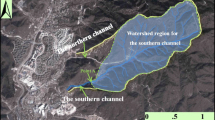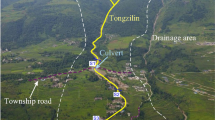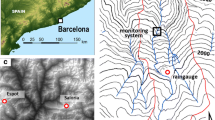Abstract
Debris flows are highly unpredictable and mechanically chaotic phenomena that can spread or branch away from an expected path or pre-existing channel, a phenomenon termed avulsion. While avulsion is expected to occur over long time periods on mature debris fans, it can also occur on short time scales and outside of active portions of fans. This was the case during the 9–13 September 2013 rainstorm event that triggered over 1000 debris flows in the Colorado Front Range. This research examines the geomorphic and topographic characteristics of debris flows during this event to identify the controlling variables of avulsion during singular events. Avulsion was observed in 1/3 of the debris flows, which were classified into 5 distinct behaviors and thus hazard implications, including directional change, distributary, split, free spreading, and braided. Debris flows that avulsed were twice as long and 6 times more likely to have path obstructions than non-avulsed paths. Additionally, locations along a debris-flow path with low lateral confinement and decreasing slope angles were more prone to avulsion. The high frequency of avulsed debris flows during the 2013 rainstorm event emphasizes the importance of considering avulsion potential during debris-flow mitigation design. The common characteristics of avulsed flows highlighted here could be incorporated into future hazard modeling efforts.







Similar content being viewed by others
References
Baum RL, Jones ES, Alvioli M, Coe JA, Kean JW, Godt JW (2016) Map and model input and output data covering N 40.0° – 40.375° and W 105.25° – 105.625° in the northern Colorado Front Range for analysis of debris flow initiation resulting from the storm of September 9 – 13, 2013: U.S. Geological Survey data release. https://doi.org/10.5066/F7ZW1J08
Baum RL, Scheevel CR, Jones ES (2019) Constraining parameter uncertainty in modeling debris-flow initiation during the September 2013 Colorado Front Range storm. In Association of Environmental and Engineering Geologists; special publication 28. Colorado School of Mines. Arthur Lakes Library. https://doi.org/10.25676/11124/173212
Bennet MF (2013a) Colorado congressional delegation, governor mark access to new emergency transportation funding: 21 October 2013 press release by Michael F. Senator for Colorado, Bennet, U.S
Bennet MF (2013b) Bennet, Udall welcome $62.8 million from HUD for flood recovery efforts: 5 December 2013 press release by Michael F. Bennet, U.S. Senator for Colorado
Birkeland PW, Shroba RR, Burns SF, Price AB, Tonkin PJ (2003) Integrating soils and geomorphology in mountains—an example from the Front Range of Colorado. Geomorphology. 55:329–344. https://doi.org/10.1016/S0169-555X(03)00148-X
Blair TC, McPherson JG (1998) Recent debris-flow processes and resultant form and facies of the Dolomite alluvial fan, Owens Valley, California. J Sediment Res 68:800–818. https://doi.org/10.2110/jsr.68.800
Cline ML, Cook JP, Pearthree PA, Youberg A, Webb RH (2008) Geologic mapping of debris-flow deposits in the Santa Catalina Mountains. Pima County, Arizona
Coe JA, Kean JW, Godt JW, Baum RL, Jones ES, Gochis DJ, Anderson GS (2014) New insights into debris-flow hazards from an extraordinary event in the Colorado Front Range. GSA Today 24:4–10. https://doi.org/10.1130/GSATG214A.1
Corominas J (1996) The angle of reach as a mobility index for small and large landslides. Can Geotech J 33:260–271
De Haas T, Van Den Berg W, Braat L, Kleinhans MG (2016) Autogenic avulsion, channelization and backfilling dynamics of debris-flow fans. Sedimentology. 63:1596–1619. https://doi.org/10.1111/sed.12275
De Haas T, Densmore AL, Stoffel M, Suwa H, Imaizumi F, Ballesteros-Cánovas JA, Wasklewicz T (2018) Avulsions and the spatio-temporal evolution of debris-flow fans. Earth Sci Rev 177:53–75. https://doi.org/10.1016/j.earscirev.2017.11.007
Dickinson WR, Klute MA, Hayes MJ, Janecke SU, Lundin ER, Mckittrick MA, Olivares MD (1988) Paleogeographic and paleotectonic setting of Laramide sedimentary basins in the central Rocky Mountain region. Bull Geol Soc Am. https://doi.org/10.1130/0016-7606(1988)100<1023:PAPSOL>2.3.CO;2
Godt JW, Coe JA, Kean JW, Baum RL, Jones ES, Harp EL, Staley DM, Barnhart WD (2014) Landslides in the northern Colorado Front Range caused by rainfall, September 11–13, 2013: U.S. Geological Survey Fact Sheet 2013–3114, 6 p. https://doi.org/10.3133/fs20133114
Iverson RM (2014) Debris flows: behaviour and hazard assessment. Geol Today 30:15–20
Levin MH, Marr JW (1963) Ecosystems of the East Slope of the Front Range in Colorado. Bull Torrey Bot Club 90:268. https://doi.org/10.2307/2483242
McGuire LA, Rengers FK, Kean JW, Coe JA, Mirus BB, Baum RL, Godt JW (2016) Elucidating the role of vegetation in the initiation of rainfall-induced shallow landslides: insights from an extreme rainfall event in the Colorado Front Range. Geophys Res Lett 43:9084–9092. https://doi.org/10.1002/2016GL070741
Pederson CA (2014) Compensational behavior of three debris-flow fans in southern Colorado (Doctoral dissertation, Colorado School of Mines. Arthur Lakes Library). http://hdl.handle.net/11124/472
Pederson CA, Santi PM, Pyles DR (2015) Relating the compensational stacking of debris-flow fans to characteristics of their underlying stratigraphy: implications for geologic hazard assessment and mitigation. Geomorphology. 248:47–56. https://doi.org/10.1016/j.geomorph.2015.06.030
Reitz MD, Jerolmack DJ (2012) Experimental alluvial fan evolution: channel dynamics, slope controls, and shoreline growth. J Geophys Res Earth Surf 117. https://doi.org/10.1029/2011JF002261
Rengers FK, McGuire LA, Coe JA, Kean JW, Baum RL, Staley DM, Godt JW (2016) The influence of vegetation on debris-flow initiation during extreme rainfall in the northern Colorado Front Range. Geology 44:823–826. https://doi.org/10.1130/G38096.1
Riley SJ, DeGloria SD, Elliot R (1999) Index that quantifies topographic heterogeneity. Int J Therm Sci 5:23–27
Santi PM, Pyles DR, Pederson CA (2017) Debris flow avulsion. Int J Eros Control Eng 10:67–73
Schürch P, Densmore AL, Rosser NJ, McArdell BW (2011) A novel debris-flow fan evolution model based on debris flow monitoring and lidartopography. In: Fifth International Conference on Debris-Flow Hazards Mitigation–Mitigation, Mechanics, Prediction and Assessment (Ed. R. Genevois,D.L. Hamilton and A. Prestininzi), 263–272. Casa Editrice Universita La Sapienza, Padua.
Straub KM, Paola C, Mohrig D, Wolinsky MA, George T (2009) Compensational stacking of channelized sedimentary deposits. J Sediment Res 79:673–688. https://doi.org/10.2110/jsr.2009.070
Suwa H, Okuda S (1983) Deposition of debris flows on a fan surface Mt. Yakedake. Japan. Zeitschrift für Geomorphologie. Supplementband 46:79–101
Tiranti D, Cremonini R, Asprea I, Marco F (2016) Driving factors for torrential mass-movements occurrence in the Western Alps. Front Earth Sci 4. https://doi.org/10.3389/feart.2016.00016
Whipple KX, Dunne T (1992) The influence of debris-flow rheology on fan morphology, Owens Valley, California. Geol Soc Am Bull. https://doi.org/10.1130/0016-7606(1992)104<0887:TIODFR>2.3.CO;2
Wilford DJ, Sakals ME, Innes JL, Sidle RC, Bergerud WA (2004) Recognition of debris flow, debris flood and flood hazard through watershed morphometrics. Landslides. 1:61–66. https://doi.org/10.1007/s10346-003-0002-0
Author information
Authors and Affiliations
Corresponding author
Ethics declarations
Conflict of interest
The authors declare that they have no conflict of interest.
Rights and permissions
About this article
Cite this article
Schaefer, L.N., Santi, P.M. & Duron, T.C. Debris flow behavior during the September 2013 rainstorm event in the Colorado Front Range, USA. Landslides 18, 1585–1595 (2021). https://doi.org/10.1007/s10346-020-01590-5
Received:
Accepted:
Published:
Issue Date:
DOI: https://doi.org/10.1007/s10346-020-01590-5




